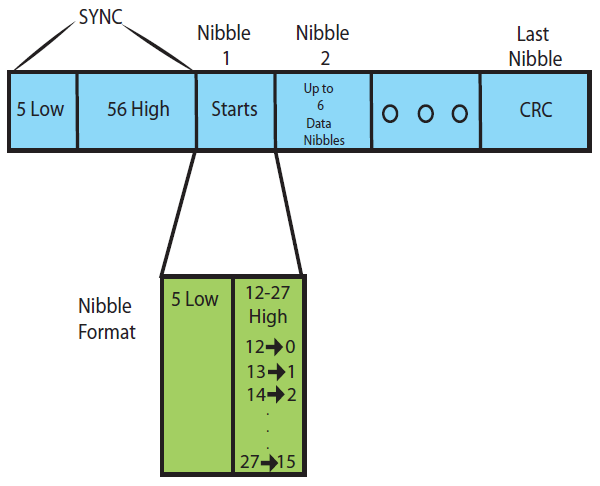|
The SENT (Single Edge Nibble Transmission) protocol is a relatively new protocol used in the automotive industry for transmitting sensor data to a controller. The SENT protocol is a one-way asynchronous voltage interface which requires three wires, a signal line, a supply voltage line and a ground line. SENT uses pulse width modulation to encode 4 bits (1 nibble) of data per symbol.
The basic unit of time in SENT is a tick, which can be between 3-90us. Each SENT message contains a sync period, made up of 5 low ticks and 56 high ticks, followed by up to 8 nibbles of data. Each data nibble is transmitted with a fixed-width low period of 5 ticks, followed by a variable-length high period from 12 to 27 ticks representing a nibbles value from 0 to 15. The data portion of the SENT message is make up of a status nibble, 1 to 6 nibbles of sensor measurements and a CRC nibble. Additionally, an option pause pulse can be used to compensate for variable message lengths.
Some of Microchip's newer PIC® microcontrollers, the dsPIC33EV256GM106 family for example, comes with a build-in SENT peripheral for transmitting or receiving SENT messages. The CCS C Compiler has build-in functions for setting up and using the SENT peripheral For these devices. The devices that have a SENT peripheral, the following functions will be available in the compiler for setting up and using the SENT peripheral: setup_sent(), sent_putd(), sent_getd() and sent_status().
The setup_sent() function is used to setup the SENT peripheral and has a parameter for setting up as an asynchronous SENT transmitter, synchronous SENT transmitter or a SENT receiver and the number of data nibbles to sent or receive. Other settings include whether to use the pause pulse.
The sent_putd() function is used to load the data nibbles to transmit when the peripheral is setup as a SENT transmitter, and the sent_getd() function is used to retrieve the data nibbles when the peripheral is setup as a SENT receiver. Finally, the sent_status() function is used to get the status of the SENT peripheral, for example what nibble it is currently transmitting or receiving.
The CCS C Compiler also provides two examples ex_sent_transmitter.c and ex_sent_receiver.c showing how use the SENT peripheral and built-in functions. ex_sent_transmitter.c is an example demonstrating how to setup and use the SENT peripheral as an asynchronous SENT transmitter, and ex_sent_receiver.c is an example show how to setup and use the SENT peripheral as a SENT receiver.

Like us on Facebook. Follow us on Twitter.
About CCS:
CCS is a leading worldwide supplier of embedded software development tools that enable companies to develop premium products based on Microchip PIC® MCU and dsPIC® DSC devices. Complete proven tool chains from CCS include a code optimizing C compiler, application specific hardware platforms and software development kits. CCS' products accelerate development of energy saving industrial automation, wireless and wired communication, automotive, medical device and consumer product applications. Established in 1992, CCS is a Microchip Premier 3rd Party Partner. For more information, please visit https://www.ccsinfo.com.
PIC® MCU, MPLAB® IDE, MPLAB® ICD2, MPLAB® ICD3 and dsPIC® are registered trademarks of Microchip Technology Inc. in the U.S. and other countries.
|